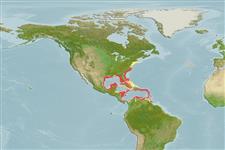Environment: milieu / climate zone / depth range / distribution range
Ecologia
marinhas; estuarina associadas(os) a recifes; oceanódromo (Ref. 51243); intervalo de profundidade 30 - 100 m (Ref. 5222), usually 30 - 100 m (Ref. 5222). Subtropical; 41°N - 8°N, 98°W - 25°W (Ref. 5222)
Western Central Atlantic: Gulf of Mexico and east coast of US from North Carolina to Key West and along the southern shore of the Caribbean Sea. Juveniles are occasionally found as far north as Massachusetts.
Length at first maturity / Tamanho / Peso / Idade
Maturity: Lm 33.2 range ? - ? cm
Max length : 107 cm TL macho/indeterminado; (Ref. 89707); common length : 30.0 cm TL macho/indeterminado; (Ref. 3708); peso máx. Publicado: 14.2 kg (Ref. 40637); Idade máx. registada: 21 anos (Ref. 6846)
Espinhos dorsais (total) : 11; Raios dorsais moles (total) : 16 - 18; Espinhos anais: 3; Raios anais moles: 10 - 12. Distinguished by the following characteristics: four color patterns, first is brown phase with head and body pale brown covered with small reddish brown spots that extend onto median fins, second is cat's paw phase with pale brown body color with dorsolateral parts of body having several clusters of dark brown spots resembling the paw print of a cat, third is with large adults with grey-head phase with the rear two-thirds of the body dark, head and body anterior to the 6th dorsal-fin spine in silvery grey with dark reticulations and fourth is bicoloured phase with pale brown anteriorly and abruptly dark chocolate brown posteriorly; depth of body contained 3.0-3.4 times in SL; head length 2.6-3.0 times in SL; convex interorbital area; angular preopercle, angle with distinct bony lobe; serrate interopercle and subopercle; posterior nostrils of adults 2-4 times larger than anterior ones (Ref. 89707).
Found over ledges and high-relief rocky bottoms in the eastern Gulf of Mexico; at low-profile bottoms at depths of 30 to 100 m in North Carolina; this species was the most abundant grouper in areas of living Oculina coral formations at depths of 70 to 100 m off the east coast of Florida. This species apparently moved inshore when bottom temperature fell below 8.6°C. Juveniles found in shallow water at jetties and in mangrove areas.
Life cycle and mating behavior
Maturidade | Reprodução | Desova | Ovos | Fecundidade | Larvas
Heemstra, P.C. and J.E. Randall, 1993. FAO Species Catalogue. Vol. 16. Groupers of the world (family Serranidae, subfamily Epinephelinae). An annotated and illustrated catalogue of the grouper, rockcod, hind, coral grouper and lyretail species known to date. Rome: FAO. FAO Fish. Synop. 125(16):382 p. (Ref. 5222)
Categoria na Lista Vermelha da IUCN (Ref. 130435: Version 2024-1)
Ameaça para o homem
Harmless
Utilização humana
Pescarias: altamente comercial; peixe desportivo: sim
Ferramentas
Relatórios especiais
Descarregue XML
Fontes da internet
Estimates based on models
Preferred temperature (Ref.
123201): 20.7 - 27.5, mean 24.4 °C (based on 130 cells).
Phylogenetic diversity index (Ref.
82804): PD
50 = 0.5000 [Uniqueness, from 0.5 = low to 2.0 = high].
Bayesian length-weight: a=0.00933 (0.00426 - 0.02047), b=3.05 (2.88 - 3.22), in cm total length, based on LWR estimates for this Genus-body shape (Ref.
93245).
Nível Trófico (Ref.
69278): 4.5 ±0.0 se; based on diet studies.
Resiliência (Ref.
120179): Baixo, tempo mínimo de duplicação da população 4,5 - 14 anos (K=0.09-0.17; tmax=21).
Fishing Vulnerability (Ref.
59153): High to very high vulnerability (69 of 100).
Climate Vulnerability (Ref.
125649): Moderate to high vulnerability (52 of 100).
Nutrients (Ref.
124155): Calcium = 11.7 [6.1, 26.2] mg/100g; Iron = 0.425 [0.208, 0.783] mg/100g; Protein = 19.6 [17.7, 21.3] %; Omega3 = 0.224 [0.128, 0.407] g/100g; Selenium = 18.8 [9.1, 37.6] μg/100g; VitaminA = 67 [18, 279] μg/100g; Zinc = 0.582 [0.373, 0.907] mg/100g (wet weight);
